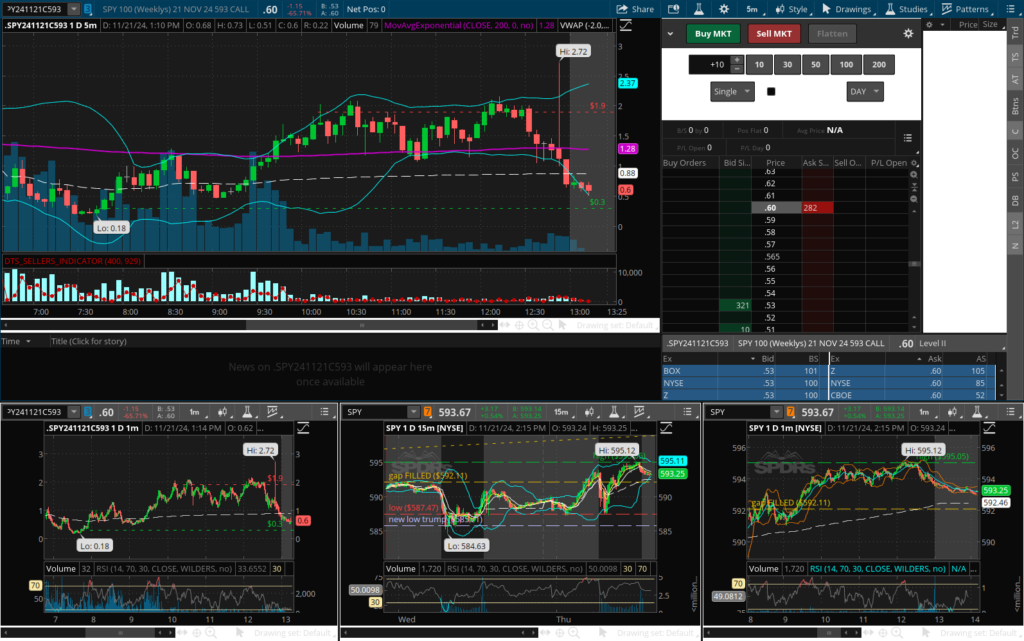Options trading can be an exciting but complex world, and one of the most talked-about trends in the options market is “0DTE options.” Short for “Zero Days to Expiration,” these options have become increasingly popular among traders seeking quick profits. But what are they, and how do they work? Let’s dive in!
Understanding 0DTE Options

What Are 0DTE Options?
These options are contracts that expire on the same day they are traded. Unlike options with longer expiration periods, these contracts have a lifespan measured in hours rather than days, weeks, or months. Traders use them to make short-term bets on price movements, often driven by daily events like earnings reports or Federal Reserve announcements.
Key Characteristics:
- Ultra-short lifespan: These contracts expire at the end of the trading day.
- High risk, high reward: Prices can change rapidly, offering the potential for significant gains—or losses—within hours.
- Low premiums: Because of their short duration, 0DTE options often have lower costs than longer-dated options.
If you’re unfamiliar with how options work, consider reviewing terms like call options and put options for a foundation.
How They Work
When trading day trading specifically, you’re predicting how a stock, index, or ETF will perform by the end of the trading day. Here’s a simplified breakdown:
- Choose the Underlying Asset: Select a stock or index you believe will have significant price movement. The S&P 500 (SPX) is a popular choice among 0DTE traders because of its high liquidity and frequent price fluctuations.
- Pick a Strike Price and Direction: Decide whether the asset will rise (buy a call option) or fall (buy a put option).
- Monitor the Market: Since 0DTE options have such a short time-frame, even small movements in the underlying asset can lead to significant changes in the option’s value.
- Close the Position or Let It Expire: You can sell the option before expiration to lock in profits or minimize losses. Alternatively, you can let it expire:
- In-the-money (ITM): The option has value, and you may exercise it.
- Out-of-the-money (OTM): The option expires worthless, resulting in a total loss of the premium paid.
Advantages:
- High Leverage: With minimal upfront costs, traders can gain significant exposure to price movements. A small price change in the underlying asset can result in large percentage returns.
- Quick Profits: Since these options expire the same day, they’re ideal for traders who want fast results without holding positions overnight.
- Focused Risk: The maximum loss is limited to the premium paid for the option, making it easier to manage risk compared to strategies like short selling.
- Opportunities Around Volatility: 0DTE options are often used during high-volatility events such as earnings announcements or economic data releases, where prices can move dramatically.
Risks:
- Time Decay (Theta): Options lose value as they approach expiration. For 0DTE options, this time decay is extremely rapid, which can quickly erode your investment. Learn more about theta.
- High Volatility: Prices can swing dramatically within minutes, leading to unexpected losses. If the market doesn’t move as predicted, your entire investment could disappear.
- Emotional Stress: The fast-paced nature of 0DTE trading can be overwhelming, especially for beginners. Keeping a level head under pressure is essential.
- Liquidity Issues: While popular assets like SPX and NASDAQ-100 (NDX) tend to have liquid 0DTE markets, less-traded assets might present challenges when entering or exiting positions.
Who Trades The High Risk Options?
Although they are not suitable for everyone. Typically, they attract:
- Day Traders: Traders looking to capitalize on intraday price swings often use 0DTE options as part of their strategy.
- Professional Traders: Hedge funds and institutional investors may use these options for short-term hedging or speculative purposes.
- Experienced Retail Investors: Seasoned traders with a deep understanding of options mechanics may trade 0DTE options for high-risk, high-reward opportunities.
Strategies:
1. Buying Calls or Puts
When to Use: When you expect a strong directional move in the underlying asset.
Example: If you think the SPX will rise sharply, buy a call option. If you believe it will drop, buy a put.
2. Iron Condors
When to Use: During periods of low volatility when you expect the underlying asset to stay within a specific range.
How It Works: Sell a call and a put at strike prices closer to the current price, and buy calls and puts further away to limit risk.
3. Scalping with Spreads
When to Use: When you want to limit risk and take small, quick profits.
Example: Use vertical spreads (buy AND sell options at different strike prices) to offset premium costs.
Tips for Beginners
- Start Small: Use a small portion of your portfolio to experiment with trades until you gain confidence.
- Understand the Greeks: Concepts like delta, gamma, and theta are crucial. For a detailed guide, see this options Greeks overview.
- Set Stop-Losses: Limit potential losses by setting predefined exit points.
- Watch Market News: Stay informed about events that could trigger sudden price movements. Tools like Earnings Calendars can help you track upcoming announcements.
- Practice First: Use a “paper trading account” to practice 0DTE strategies without risking real money. Many brokers offer these tools.
Conclusion:
This can be an exciting way to trade, offering the potential for quick profits. However, they are not for everyone due to their high risk and fast-paced nature. Beginners should approach with caution, focus on education, and practice extensively before diving in.
- See this post on how buying a call option works for a more info.
For experienced traders who can manage the risks, 0DTE options can be a powerful addition to a trading strategy. With the right knowledge, tools, and discipline, you can navigate this dynamic market with confidence.
Remember, the stock market rewards preparation and patience. Take your time to learn, and you’ll be better equipped to make informed trading decisions.
> Recommended: brokerage for trading > tastytrade.com.
> Recommended: order flow heatmap > bookmap.com.



